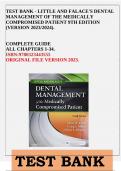TEST BANK - LITTLE AND FALACE'S DENTAL
MANAGEMENT OF THE MEDICALLY
COMPROMISED PATIENT 9TH EDITION
(VERSION 2023/2024).
COMPLETE GUIDE
ALL CHAPTERS 1-34.
ISBN:9780323443555
ORIGINAL FILE VERSION 2023.
TEST BANK
, WWW.GRADESMORE.COM
Stuvia.com - The Marketplace to Buy and Sell your Study Material
Page 1 of 74
Chapter 01: Patient Evaluation and Risk Assessment
Little: Dental Management of the Medically Compromised Patient, 9th Edition
MULTIPLE CHOICE
1. Elective dental care should be deferred for patients with severe, uncontrolled hypertension,
meaning that the blood pressure is greater than or equal to mm Hg.
a. 200/140
b. 180/140
c. 180/110
d. 160/110
ANS: C
Elective dental care should be deferred for patients with severe, uncontrolled hypertension,
which is blood pressure greater than or equal to 180/110 mm Hg, until the condition can be
brought under control.
2. The American Heart Association currently recommends antibiotic prophylaxis for a patient
with which of the following cardiac conditions?
a. Mitral valve prolapse
b. Prosthetic heart valve
c. Rheumatic heart disease
d. Pacemakers for cardiac arrhythmias
ANS: B
Previously, the American Heart Association (AHA) recommended antibiotic prophylaxis for
many patients with heart murmurs caused by valvular disease (e.g., mitral valve prolapse,
rheumatic heart disease) in an effort to prevent infective endocarditis; however, current
guidelines omit this recommendation on the basis of accumulated scientific evidence. If a
murmur is due to certain specific cardiac conditions (e.g., previous endocarditis, prosthetic
heart valve, complex congenital cyanotic heart disease), the AHA continues to recommend
antibiotic prophylaxis for most dental procedures.
3. One consequence of chronic hepatitis (B or C) or cirrhosis of the liver is decreased ability of
the body to certain drugs, including local anesthetics and analgesics.
a. absorb
b. distribute
c. metabolize
d. excrete
ANS: C
Patients also may have chronic hepatitis (B or C) or cirrhosis, with impairment of liver
function. This deficit may result in prolonged bleeding and less efficient metabolism of
certain drugs, including local anesthetics and analgesics.
4. Which of the following symptoms and signs is most consistent with allergy?
a. Heart palpitations
b. Itching
c. Vomiting
d. Fainting
WWW.NURSYLAB.COM
GRADESMORE.COM
, WWW.GRADESMORE.COM
Stuvia.com - The Marketplace to Buy and Sell your Study Material
Page 1 of 74
ANS: B
Symptoms and signs consistent with allergy include itching, urticaria (hives), rash, swelling,
wheezing, angioedema, runny nose, and tearing eyes. Isolated signs and symptoms such as
nausea, vomiting, heart palpitations, and fainting generally are not of an allergic origin but
rather are manifestations of drug intolerance, adverse side effects, or psychogenic reactions.
5. Which of the following is true of the patient with a history of tuberculosis?
a. A positive result on skin testing means that the person has active TB.
b. Most patients who become positive skin testers develop active disease.
c. Patients with acquired immunodeficiency syndrome (AIDS) have a high incidence
of tuberculosis.
d. A diagnosis of active TB is made by a purified protein derivative (PPD) skin test.
ANS: C
The potential coexistence of tuberculosis and acquired immunodeficiency syndrome (AIDS)
should be explored because patients with AIDS have a high incidence of tuberculosis. A
positive result on skin testing means specifically that the person has at some time been
infected with TB, not necessarily that active disease is present. Most patients who become
positive skin testers do not develop active disease. A diagnosis of active TB is made by chest
x-ray, imaging, sputum culture, and clinical examination.
6. Vasoconstrictors should be avoided in patients who cocaine or methamphetamine users
because these agents may precipitate .
a. severe hypotension
b. severe hypertension
c. respiratory depression
d. cessation of intestinal peristalsis
ANS: B
Vasoconstrictors should be avoided in patients who are cocaine or methamphetamine users
because the combination may precipitate arrhythmias, MI, or severe hypertension.
7. It has been shown that the risk for occurrence of a serious perioperative cardiovascular event
(e.g., MI, heart failure) is increased in patients who are unable to meet a -MET (metabolic
equivalent of task) demand during normal daily activity.
a. 4
b. 6
c. 8
d. 10
ANS: A
Daily activities requiring 4 METs include level walking at 4 miles/hour or climbing a flight of
stairs. Activities requiring greater than 10 METs include swimming and singles tennis. An
exercise capacity of 10 to 13 METs indicates excellent physical conditioning.
8. Which of the following alterations in the fingernails is associated with cirrhosis?
a. Yellowing
b. Clubbing
c. White discoloration
d. Splinter hemorrhages
WWW.NURSYLAB.COM
GRADESMORE.COM
, WWW.GRADESMORE.COM
Stuvia.com - The Marketplace to Buy and Sell your Study Material
Page 1 of 74
ANS: C
Alterations in the fingernails, such as clubbing (seen in cardiopulmonary insufficiency), white
discoloration (seen in cirrhosis), yellowing (from malignancy), and splinter hemorrhages
(from infective endocarditis) usually are caused by chronic disorders.
9. A blood pressure cuff should be placed on the upper arm and inflated until .
a. the radial pulse disappears
b. the radial pulse disappears and then inflated an additional 20 to 30 mm Hg
c. two fingers cannot fit comfortably under the cuff
d. the pulse no longer can be heard with the stethoscope
ANS: B
While the radial pulse is palpated, the cuff is inflated until the radial pulse disappears
(approximate systolic pressure); it is then inflated an additional 20 to 30 mm Hg.
10. Which of the following is true of a patient classified ASA III according to the American
Society of Anesthesiologists (ASA) Physical Status Classification System?
a. Patient has mild systemic disease.
b. Patient’s disease has significant impact on daily activity.
c. Patient’s disease is unlikely to have impact on anesthesia and surgery.
d. Patient is moribund.
ANS: B
Patient with severe systemic disease is a constant threat to life (e.g., recent myocardial
infarction, stroke, transient ischemic attach [<3 months], ongoing cardiac ischemia, severe
valve dysfunction, respiratory failure requiring mechanical ventilation). Serious limitation of
daily activity; likely major impact on anesthesia and surgery.
WWW.NURSYLAB.COM
GRADESMORE.COM




